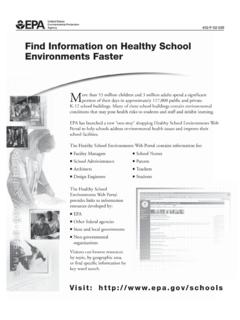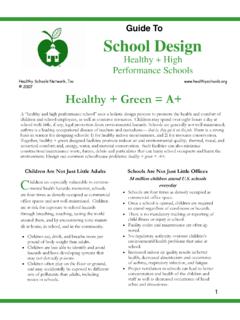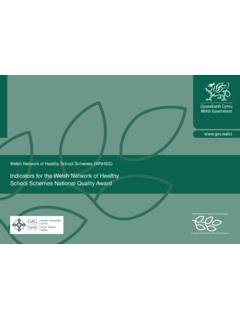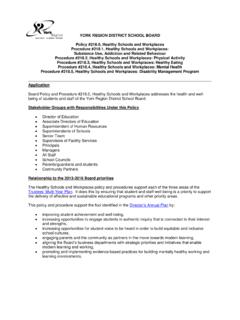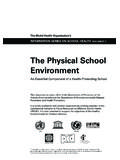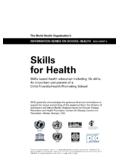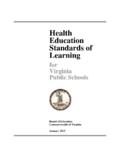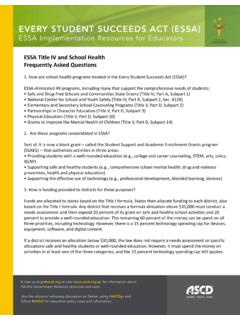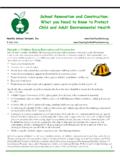Transcription of 3Ts for Reducing Lead - US EPA
1 3Ts for Reducing Lead in drinking water in Schools Revised Technical Guidance This October 2006 version of the 3Ts for Reducing Lead in drinking water in Schools: Revised Technical Guidance is a modification of the December 2005 version. The modifications in this version clarify the instructions for collecting samples from drinking water outlets, please see sections , , and Additionally, EPA made some minor modifications to the nomenclature in Chapter 4. Please visit for the complete Errata sheet. Disclaimer This manual contains recommendations on how to address lead in school drinking water systems; these are suggestions only and are not requirements. This manual does, however, also contain an overview of requirements concerning lead in drinking water . The statutory provisions and regulations described in this document contain binding requirements.
2 The general description here does not substitute for those laws or regulations; nor is this document a regulation itself. As a result, you will need to be familiar with the details of the rules that are relevant to your school drinking water ; you cannot rely solely on this guidance for compliance information. Also, many states (or tribes) and localities have different, more stringent requirements than EPA's, so you will need to find out what other laws and regulations apply to school drinking water in addition to the ones described here. 3Ts for Reducing Lead in drinking water in Schools: Revised Technical Guidance Contents Introduction .. 4. I. Training .. 6. 1. What You Should Know about Lead in drinking water .. 6. Health Effects of Lead .. 6. Sources of Lead .. 6. How Lead Gets into drinking water .
3 7. How Lead in drinking water is Regulated .. 11. 2. Planning Your Program and Establishing Partnerships .. 13. Assigning Roles .. 13. school Records .. 13. Establishing Partnerships .. 13. Assistance from Your Public water Supplier .. 13. Assistance from Your Local Health Office .. 15. Assistance from Your State drinking water Program .. 15. Assistance from Certified Laboratories .. 15. Assistance from Local Community Organizations .. 16. II. Testing .. 17. 3. Assessment and Strategy: Plumbing Profile and Sampling Plan .. 17. Development of a Plumbing Profile for Your Facility's Plumbing .. 17. Who Should Create the Sampling Plan? - Leadership in Sampling .. 24. Where Should I Sample? - Determining Sample Locations .. 24. Who Should Collect the Samples and Where Do Samples Go for Analysis?
4 Collection and Analysis of Samples .. 25. 4. Conducting Sampling .. 28. General Sampling Procedures .. 28 Collection Procedures .. 28. Laboratory Analysis and Handling of Sample Containers .. 29. Overview of the Two-Step Sampling Process .. 29. Step 1: Initial Sampling .. 29. Step 2: Follow-Up Sampling .. 30. Initial and Follow-Up Sampling Protocol .. 33. Sampling for Other Parameters .. 36. 1. 3Ts for Reducing Lead in drinking water in Schools: Revised Technical Guidance 5. Remedies .. 55. Routine Control Measures .. 55. Interim (Short-Term) Control Measures .. 55. Permanent Remedies .. 57. III. Telling .. 65. 6. Informing the Public about Lead .. 65. Techniques for Disseminating Public Information .. 65. The Components of an Effective General Communication Strategy .. 66. Participants.
5 66. Timing .. 67. Content .. 67. Methods and Manner of Communication .. 67. Sample Public Notice Materials .. 68 Appendix A Glossary of Terms .. 73. Appendix B Publication List .. 75. Appendix C Resources .. 77. Appendix D List of State drinking water Programs .. 78. Appendix E water Cooler Summary .. 86. Appendix F Sample Recordkeeping Form .. 89. Appendix G Preservation of Samples and Sample Containers .. 90. Appendix H Example Scenarios for water Sample Results .. 91. Appendix I Plumbing Profile Questionnaire .. 96. 2. 3Ts for Reducing Lead in drinking water in Schools: Revised Technical Guidance Exhibits Exhibit : Potential Sources of Lead in Schools .. 9. Exhibit : Common drinking water Outlets .. 10 Exhibit : Sample Plumbing Profile Questionnaire .. 18. Exhibit : Plumbing Configuration for a Single-Level Building.
6 26. Exhibit : Plumbing Configuration for a Multi-Level Building .. 27. Exhibit : Pipe Volumes for Copper Pipe .. 34. Exhibit : Sample Strategy Flowchart .. 35. Exhibit : Service Connection Sampling .. 37. Exhibit : drinking water Fountains: Bubblers .. 39. Exhibit : drinking water Fountains: water Coolers .. 41. Exhibit : drinking water Fountains: Bottled water Dispensers .. 45. Exhibit : Ice Making Machines .. 46. Exhibit : water Faucets (Taps) .. 47. Exhibit : Sampling Interior Plumbing .. 48. Exhibit : Sample Sites for a Single-Level Building .. 53. Exhibit : Sample Sites for a Multi-Level Building .. 54. Exhibit : Flushing Directions by Outlet Type .. 56. Exhibit : Remediation Flow Chart (part 1) .. 60. Exhibit : Remediation Flow Chart (part 2) .. 61. Exhibit : Remediation Flow Chart (part 3).
7 62. Exhibit : Case Study 1 .. 63. Exhibit : Sample Public Notice Letter .. 69. Exhibit : Sample Press Release for Local Media .. 70. Exhibit : Sample Newsletter Article .. 71. 3. 3Ts for Reducing Lead in drinking water in Schools: Revised Technical Guidance Introduction The environmental Protection Agency (EPA) developed this guidance manual because the Agency is concerned about the potential for elevated lead levels in drinking water in schools. Children are most susceptible to the effects of lead, because their bodies are still undergoing development. The adverse health effects from lead include reduced IQ and attention span, learning disabilities, poor classroom performance, hyperactivity, behavioral problems, impaired growth, and hearing loss. There is no federal law requiring testing of drinking water in schools, except for schools that have their own water supply and are thus regulated under the Safe drinking water Act (SDWA).
8 The vast majority of public water suppliers do not include schools in their sampling plans because regulations (specifically the Lead and Copper Rule) require sampling of single family dwellings. States and local jurisdictions may, however, establish their own programs for testing drinking water lead levels in schools. EPA suggests that schools implement programs for Reducing lead in drinking water as part of the school 's overall plan for Reducing environmental threats. Safe and healthy school environments foster healthy children, and may improve students' general performance. Lead most frequently gets into drinking water by leaching from plumbing materials and fixtures as water moves through your school 's distribution system. Even though the drinking water you receive from your water supplier meets federal and state standards for lead, your facility may have elevated lead levels due to plumbing materials and water use patterns.
9 Because lead concentrations can change as water moves through the distribution system, the best way to know if a school might have elevated levels of lead in its drinking water is by testing the water in that school . Testing facilitates an evaluation of the plumbing and helps target remediation. It is a key step in understanding the problem, if there is one, and designing an appropriate response. This guidance manual is intended for use by school officials responsible for the maintenance and/or safety of school facilities including the drinking water . The guidance introduces the 3Ts for Reducing lead in drinking water . The 3Ts are: f Training school officials to raise awareness of the potential occurrences, causes, and health effects of lead in drinking water ; assist school officials in identifying potential areas where elevated lead may occur; and establishing a testing plan to identify and prioritize testing sites.
10 F Testing drinking water in schools to identify potential problems and take corrective actions as necessary. f Telling students, parents, staff, and the larger community about monitoring programs, potential risks, the results of testing, and remediation actions. The purpose of this manual is to help schools minimize their students' and staff 's exposure to lead in drinking water . This manual is specifically targeted at schools that receive water from water utilities or water suppliers such as cities, towns and water districts. This guidance manual replaces the 1994 EPA guidance document Lead in drinking water in Schools and Non-Residential Buildings. By following the steps below, you will be assured your facility does not have elevated levels of lead in the drinking water . 4. 3Ts for Reducing Lead in drinking water in Schools: Revised Technical Guidance Training (1) Conduct a thorough review of this guidance document.










